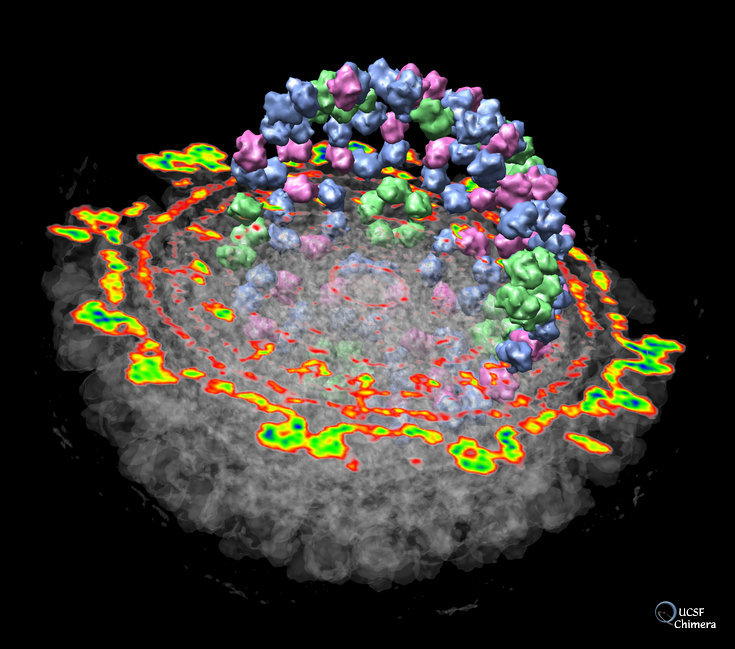博文
推荐一个非常专业的PDB分子显示软件:Chimera
||
大家对于PDB等格式的分子显示都习惯用Pymol,因为pymol比较简单,容易上手。呵呵,符合现代人懒惰的思想。虽然这样懒惰的操作也可以绘制出不错的图片,但看了chimera的作图效果后,一定会让不少人感到惭愧。
以下内容来自Chimera官方网站: http://www.cgl.ucsf.edu/chimera/
Chimera当前最新版本是1.4,支持的平台有:windows,Linux, Mac,下载地址:http://www.cgl.ucsf.edu/chimera/download.html
Chimera官方手册:http://www.cgl.ucsf.edu/chimera/current/docs/UsersGuide/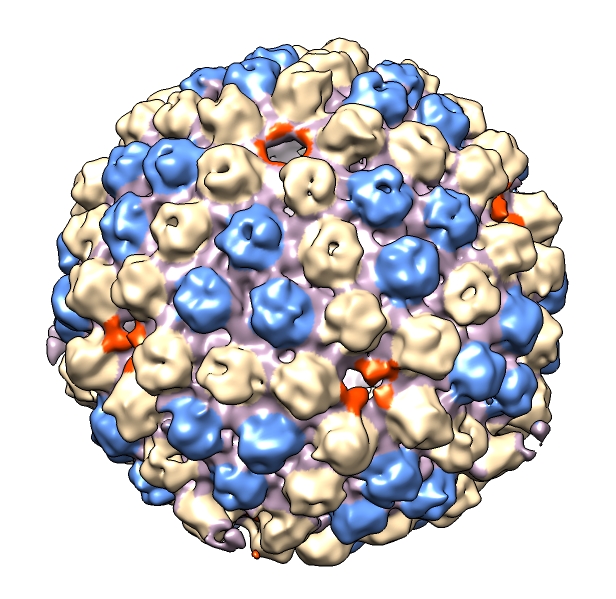
The arrangement of subunits in the capsid of herpes simplex virus type 1 is shown. Herpes virus has a portal at one of the icosahedron 5-fold vertices shown near the top in orange. The double-stranded DNA virus genome is packaged into the capsid via this portal, and when infecting a host cell is ejected through the portal and through a cell a nuclear pore.
The coloring of the density map contour surface was done with the Chimera color zone tool. A marker was centered on each capsomere using the hkcage command (lattice parameters h = 4, k = 0) and a Python script markhidden.py that created the markers at the hidden lattice vertices (centers of hexagons and pentagons).
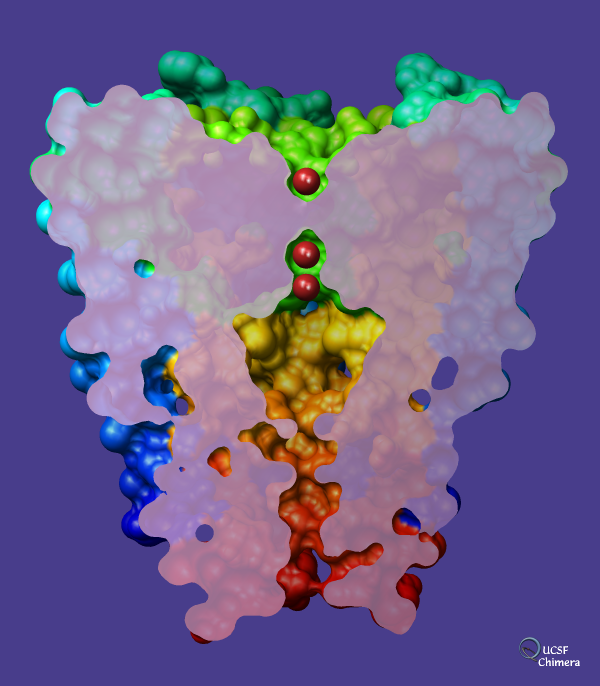
Potassium channel (Protein Data Bank entry 1bl8) on a dark slate blue background with potassium ions shown in firebrick. The channel is comprised of four chains. Each chain has been rainbow-colored from blue at the N-terminus to red at the C-terminus, but only the surface of the channel is shown. The surface has been sliced with a per-model clipping plane. The surface cap color is plum except with opacity set to 0.8. The shininess and brightness have been set to 128 and 8, respectively, and the lights on the scene have been moved from their default positions. The subdivision quality (related to the smoothness of the spherical ions) is 5.0, and the molecular surface was computed with probe radius and vertex density set to 1.0 and 6.0, respectively.
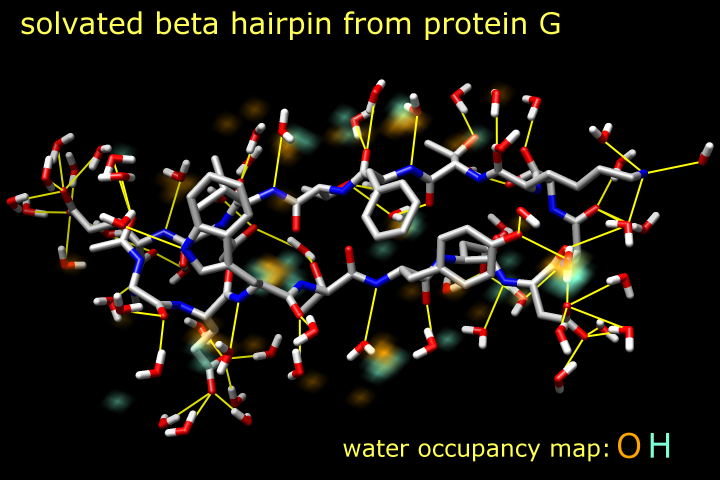
Snapshot from an AMBER simulation of the C-terminal beta hairpin from protein G. The peptide was solvated with TIP3P water in a truncated octahedral box and counterions were added to bring the system to neutrality. The system was minimized and then equilibrated for 100 ps at 300K and 1 atm using Berendsen temperature and pressure control. Finally, a 50 ps NVE production simulation was conducted, with configurations saved every 0.1 ps, generating a trajectory of 500 snapshots. Data courtesy of John Chodera, Graduate Group in Biophysics, Dill group, UCSF.
Semliki forest virus. The bowl of smoke is a 9 angstrom resolution density map from electron cryo-microscopy. The density map is sliced in half with colors from red to blue showing low to high density values on the cut surface. A capsid protein forming a shell inside this enveloped virus is shown in blue, green and pink. The virus structure is described in Mancini EJ, et al., Cryo-electron microscopy reveals the functional organization of an enveloped virus, Semliki Forest virus. Mol Cell. 2000 Feb;5(2):255-66.
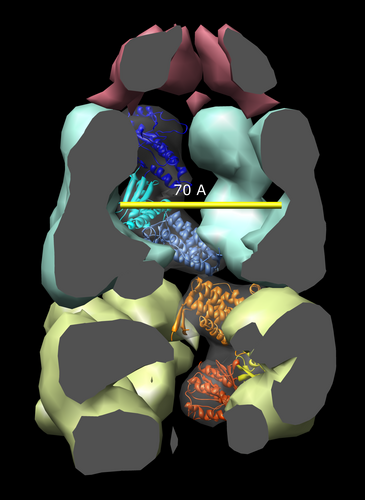
Chaperonin complex from Escherichia coli. Misfolded proteins are refolded inside the cavity formed by this 21 protein complex. The blue and yellow rings (GroEL) each consist of 7 copies of the same protein, while the red cap (GroES) is composed of 7 copies of a different protein. The two rings of GroEL exhibit different conformations. The 3 domains of the monomeric protein are positioned differently in the two rings as shown in the images below.
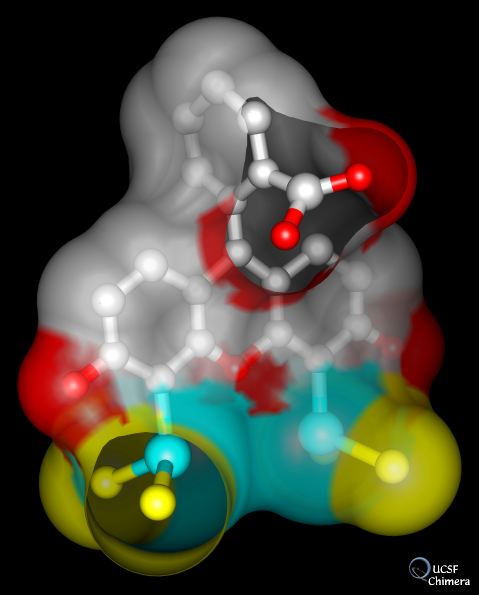
FLASH is a fluorescent molecule that can be used to label proteins in living cells (Griffin et al., Science 281:269 (1998)). The image shows FLASH in the ball-and-stick representation colored by element: carbon atoms are gray, oxygen atoms are red, sulfur atoms are yellow, and arsenic atoms are cyan. A surface with 40% transparency is shown, and has been clipped in front using the Side View. The surface attribute "vertex density" and the viewing effect "subdivision quality" have been increased tenfold from their default values to increase the smoothness of the surface and balls, respectively.
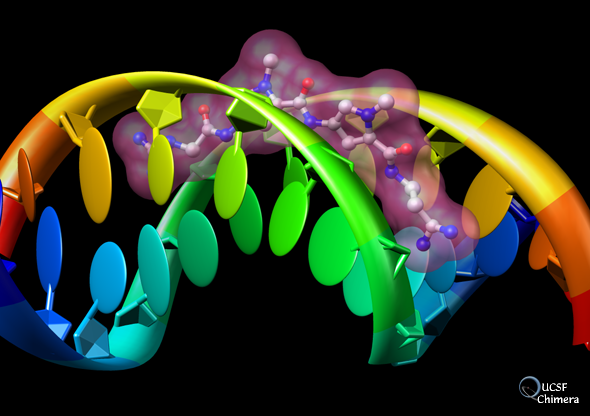
The image shows netropsin bound to double-stranded DNA (PDB entry 6bna). The DNA has been colored with the command rainbow and is shown with smooth ribbons, stick bonds, and special representations of the sugars and bases. The special representations were created with the Nucleotides extension. Netropsin is colored by element and shown in the ball-and-stick representation, with a transparent pink molecular surface. Water has been undisplayed.

The program DOCK (Kuntz group, UCSF) is typically used to search a database for compounds that may bind to a target protein structure. The Chimera tool ViewDock facilitates interactive screening of hits output from DOCK. The ViewDock interface (above, right) lists the docked molecules, and clicking on a line displays that molecule in the graphics window and shows information such as scores in the lower panel. The target structure in this example is H-Ras (PDB entry 121p), which is often mutated in malignant tumors in humans. The docked molecule is ribose monophosphate. Carbons are gray, oxygens are red, nitrogens are blue, and phosphorus is cyan. Hydrogens are not shown. Potential hydrogen bonds are shown as dashed yellow lines between donor and acceptor.
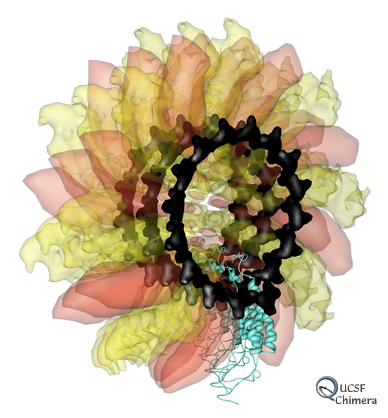
Three turns of the helical ribgrass mosaic virus (pdb identifier 1rmv) are shown using the Chimera multiscale extension. The three turns contain exactly 49 subunits. A complete virus has approximately 2100 subunits. The black coil is RNA. The red and yellow are the same protein represented using transparent surfaces with different resolutions. Different colors were used so that the subunits are easily distinguished. The blue ribbon shows the secondary structure of 3 copies of the protein.
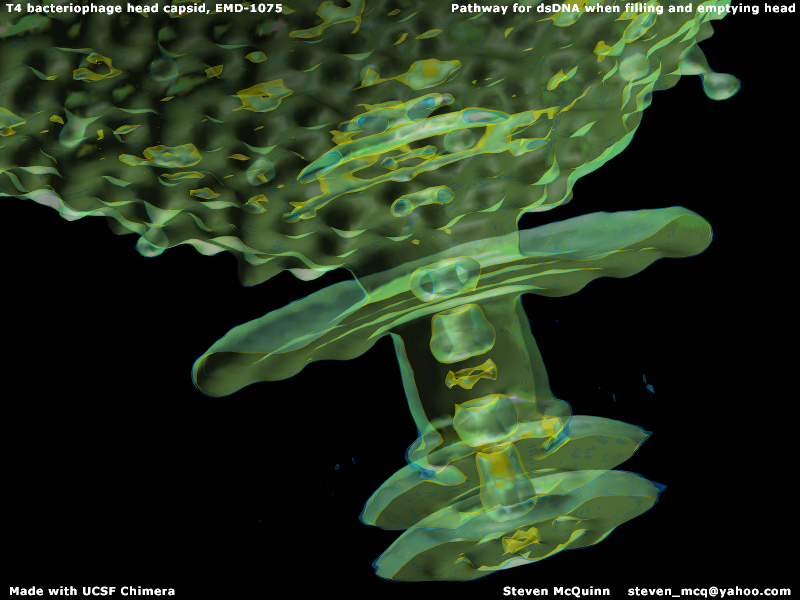
Bacteriophage T4 is a large, tailed, double-stranded DNA virus that uses Escherichia coli as a host. These images were made from a density map (22.5 angstrom resolution) obtained by electron cryo-microscopy. They show the virus head and portal to which the tail connects. More details can be found in A. Fokine, et al., PNAS (2004) 101(16):6003-8.
Images made by Steven McQuinn. A PDF file containing the all of the images is available. The data set is EMD-1075 from the Macromolecular Structure Database.

A model of Sindbis virus (PDB 1ld4) is shown using the Chimera multiscale model extension. The icosahedral virus has an outer glycoprotein shell and an inner nucleocapsid shell separated by a lipid bilayer. The glycoproteins have a coiled coil domain extending through the lipid bilayer. The model was built by fitting crystal structures of Sindbis and homolog protein components into an 11 angstrom density map obtained by cryo-electron microscopy. For more details see Wei Zhang, et al., J. Virol., (76) 11645 2002.


To create a separate map containing just the density within your surface, select the surface, and use command "mask #0 sel" (Favorites / Command Line). Here #0 is the id number of the original hiv map. Hide the surfaces with Actions / Surface / hide. Change the new map to surface display style and color it using the volume dialog color button. Redisplay the original map so the core can be seen within the original map.


Compounds are evaluated for compatibility with a binding site in HIVgp41 using NVIDIA Quadro stereo graphics. This figure was generated using Molecular Operating Environment (MOE) from Chemical Computing Group.


https://blog.sciencenet.cn/blog-355217-279198.html
上一篇:pymol 知道多少?pymol技巧汇总(内附PDF手册)
下一篇:分子力场简介 来自wiki百科
